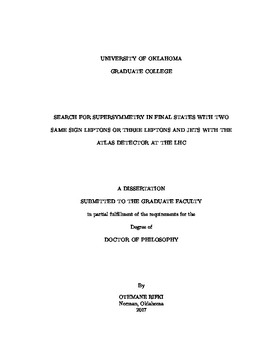| dc.contributor.advisor | Abbott, Brad | |
| dc.contributor.author | Rifki, Othmane | |
| dc.date.accessioned | 2017-07-10T18:29:33Z | |
| dc.date.available | 2017-07-10T18:29:33Z | |
| dc.date.issued | 2017-07-07 | |
| dc.identifier.uri | https://hdl.handle.net/11244/51830 | |
| dc.description.abstract | The Standard Model of particle physics is the culmination of decades of experimental and theoretical advancements
to successfully describe the elementary particles and their interactions at low energies, up to 100 GeV.
Beyond this scale lies the realm of new physics needed to remedy problems that arise at higher energies, the TeV scale and above.
Supersymmetry (SUSY) is the most favored extension of the Standard Model that solves many of its limitations, if predicted
SUSY particles exist at the TeV scale.
The Large Hadron Collider (LHC) at CERN has opened a new phase of exploration into new physics at the TeV scale
after increasing the center-of-mass energy of the proton-proton collisions to 13 TeV.
The ATLAS experiment has collected this collision data with over 90% efficiency due to the excellent performance
of many of its systems, in particular the data acquisition system.
The work realized and described in this dissertation ensures the efficient collection of ATLAS data as well as the analysis
of this data to search for SUSY.
The first part is devoted to the migration of the functionality of the multi-card custom electronics
Region of Interest Builder (RoIB), a central part of the data acquisition system which processes every event recorded by ATLAS, to a single
PCI-Express card hosted in a commodity computing node. This evolution was undertaken to
increase the system flexibility and reduce the operational overload associated with custom electronics.
The second part deals with the search for strongly produced supersymmetric particles decaying into final
states with multiple energetic jets and either two leptons (electrons or muons) with the same electric
charge or at least three leptons using the whole proton-proton collision dataset of 36 fb-1 at
13 TeV recorded with the ATLAS detector in 2015 and 2016.
The analysis pioneers the search for supersymmetry with a novel experimental signature of three leptons of the same
electric charge.
Due to the low Standard Model background, these final states are particularly adapted to searches for gluinos or third generation
squarks in several SUSY production topologies determined from a variety of simplified and phenomenological models.
The main aspects of the analysis are described, in particular the methods used to estimate the various backgrounds that come
from known Standard Model production processes with a final state similar to the SUSY models being targeted,
as well as detector measurement effects.
The absence of excess over the Standard Model prediction is interpreted in
terms of limits on the masses of superpartners derived at 95% confidence
level. In the studied decay modes and depending on the decay topology, the existence of gluinos with masses below
1.9 TeV, sbottoms with masses below 700 GeV, and neutralinos with masses
below 1.2 TeV are excluded. | en_US |
| dc.language | en_US | en_US |
| dc.subject | ATLAS | en_US |
| dc.subject | High Energy Physics | en_US |
| dc.subject | Large Hadron Collider | en_US |
| dc.subject | Supersymmetry | en_US |
| dc.title | SEARCH FOR SUPERSYMMETRY IN FINAL STATES WITH TWO SAME SIGN LEPTONS OR THREE LEPTONS AND JETS WITH THE ATLAS DETECTOR AT THE LHC | en_US |
| dc.contributor.committeeMember | Abraham, Eric | |
| dc.contributor.committeeMember | Barker, Peter | |
| dc.contributor.committeeMember | Strauss, Michael | |
| dc.contributor.committeeMember | Kao, Chung | |
| dc.date.manuscript | 2017-07-07 | |
| dc.thesis.degree | Ph.D. | en_US |
| ou.group | College of Arts and Sciences::Homer L. Dodge Department of Physics and Astronomy | en_US |
